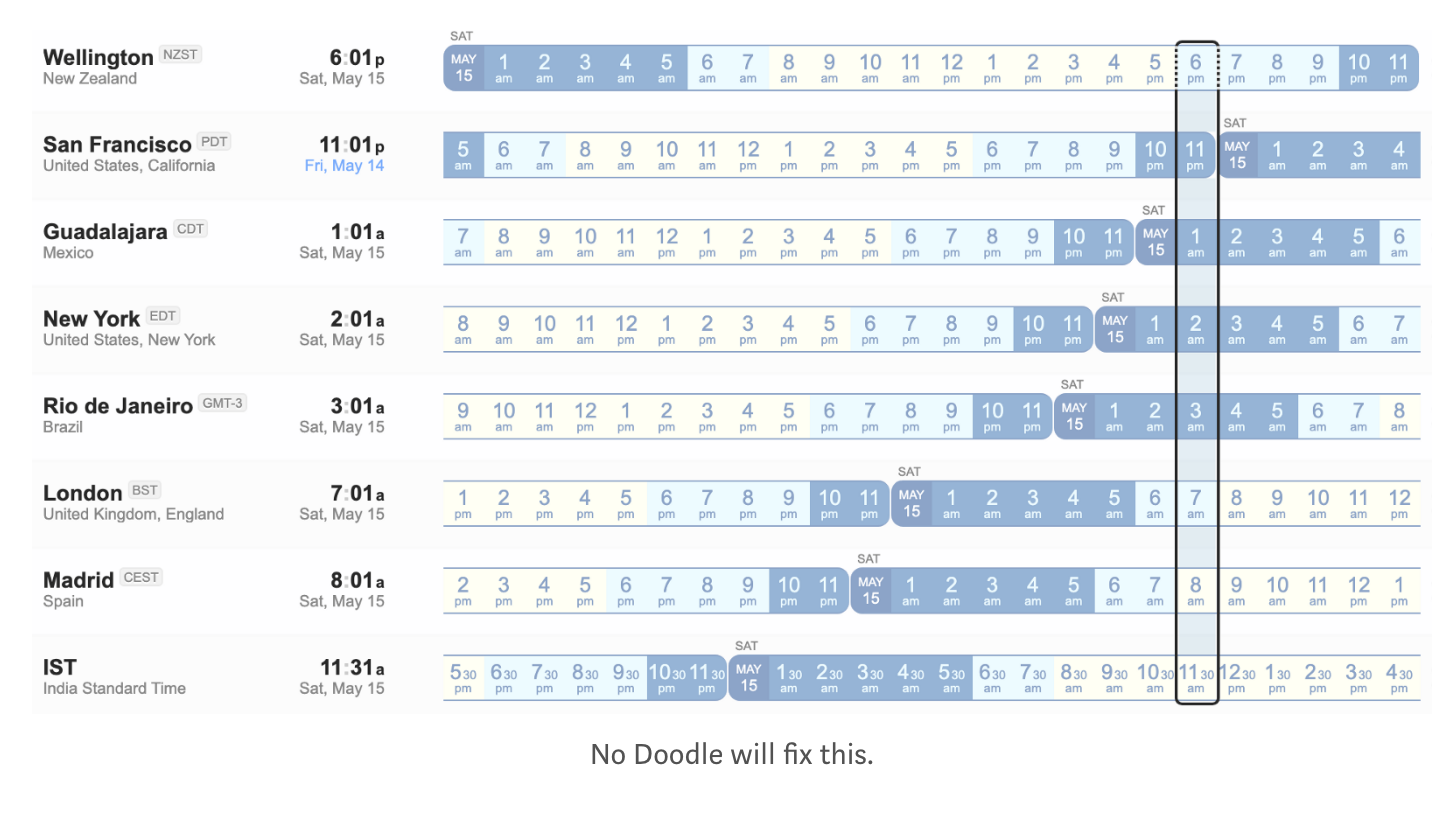Open Collective's impossible team away day

Article excerpt from Zooming Beyond Time and Space, by team member Alanna Irving.
My team at Open Collective is 13 people across Brazil, Mexico, United States, the UK, Canada, Germany, France, Spain, India, and New Zealand. We’ve been fully remote for years, but before the pandemic we had quarterly team retreats. Though not everyone could be at each one, they helped create a rhythm of connection, alignment, and shared context.
Like for everyone else, COVID19 meant we couldn’t gather anymore. We carried on, working from home, doing video calls, chatting on Slack, and updating GitHub issues. The team stayed very productive in terms of day to day, sprint to sprint collaboration.
But over time, as we hired new people and our product evolved, I could feel interpersonal connections and strategic alignment eroding. Something important was missing, a certain kind of deeper communication.
So, I tried to call a team workshop. If we couldn’t get together in person, surely we could at least get on the same call? But the time zones were impossible.

What if we could have a conversation outside of time?
As a facilitator, I felt defeated, like I was fighting the clock and losing. I had to get creative and experiment. So, I designated an upcoming week in the calendar “team retreat week” and sent everyone invitations to Loom (a video recording tool) and a #retreat Slack channel.
I explained in the context setting document:
We need to see online collaboration not as a limitation or compromise, but as an opportunity for new ways of interacting. We need to take advantage of its unique strengths.
And I set a theme: dreams. We’d start with our individual dreams, and weave them together into our collective dream by the end of the process.
Ahead of time, I assigned pairs, intentionally matching people who don’t usually work closely together. I asked them to book two 30 minute sync sessions, one early in the week and one toward the end, whenever their two calendars aligned.
On Monday, I kicked off the first of a series of daily prompts, inviting short video responses (5 minutes max). Since it was designed to be asynchronous, everyone could record and watch at any time of day.
- Monday: “This year so far, what has been your highlight and lowlight, personally and for your work?”
- Tuesday: “What’s something you’ve learned, or a way you’ve grown, in the last while? What learning and growing do you still feel you need to do?”
- First pair discussion (30 minute synchronous session): “How does the growth and learning you shared relate to your bigger dream for yourself? How does working for this company relate to that dream?”
- Wednesday: “How can the rest of the team support your pair discussion partner with their dream—what’s the call to action? And more generally, how could our team better work together and support one another?”
- Thursday: “Out of all the things you could be doing in your life, why do you choose to work here, on this project?”
- Second pair discussion: “What do we collectively need to achieve in order to do justice to the choice we’ve each made to dedicate our time to this company?”
- Friday: “What should be our real focus and strategy as a company, our collective dream? What is one risk, something that makes you worry we might not achieve it, and one advantage, a reason you’re hopeful we will?”
Outcomes
All together, we created and watched 85 short videos, and each had two 30-minute pair calls—the equivalent of an 8-hour team away day.
Some changes started before the week even finished. Just as I was logging out for the evening one day, a team member in the opposite time zone messaged on Slack requesting to have a call. I asked her to record a video instead, which I watched and responded to in the morning. Easy!
We’re shifting work in progress demos from a synchronous weekly meeting to a partly asynchronous process. Instead of a synchronous live screenshare, short videos are posted in a #demos Slack channel throughout the week, then deeper discussion happens at the weekly call. Those who can’t make the sync session can comment on Slack and catch up on the workshop recording afterward.
We’re thinking more deeply about optimising communication modes: sync/async, text/video. The interpersonal and strategic alignment impacts will show themselves over time, but I’ve already noticed better connection among team members who are part time, newer, or in distant time zones.
After the retreat, I asked for feedback and reflections. My colleague Alina summed it up perfectly.

